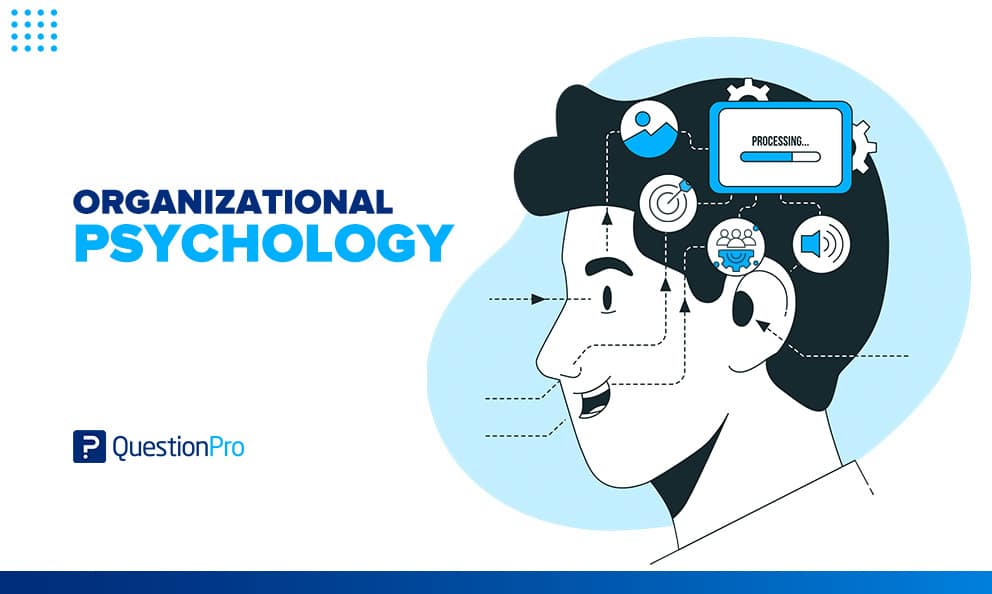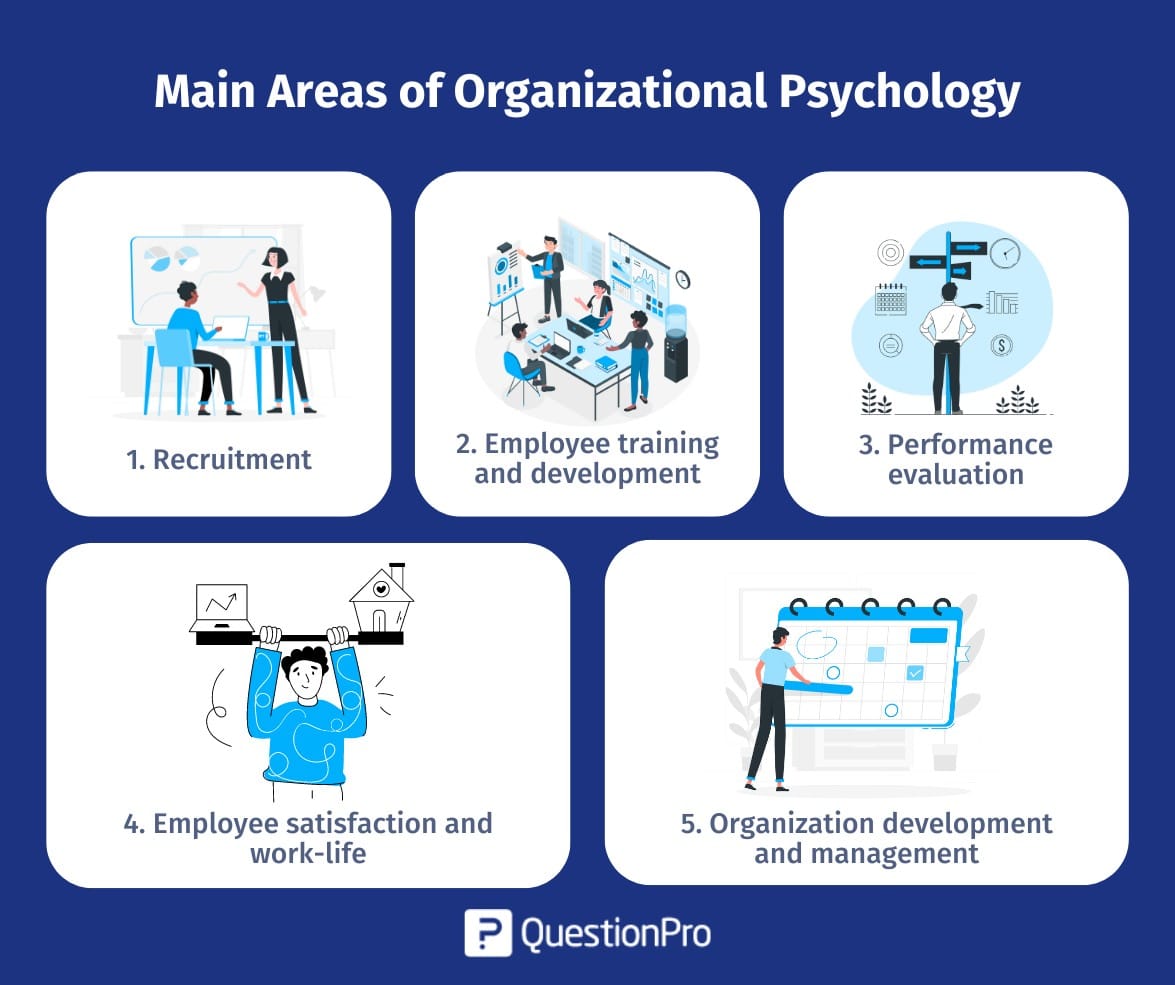
It’s been shown that engaged employees are 17% more productive than their disengaged counterparts. Sometimes, companies struggle with low employee morale, which can reduce productivity and increase turnover. Organizational Psychology help identify the key motivational drivers that boost employee satisfaction.
Organizational psychology is the part of Industrial/Organizational (I/O) Psychology that focuses on helping companies assess employees’ skills, abilities, perceptions, and potential to achieve the organization’s goals while contributing to their human and professional development.
In this article, you will learn what it consists of, its benefits, and the most important tools it uses to improve the performance and well-being of the workforce.
What is organizational psychology?
Organizational psychology is the study of human behavior in the workplace. It focuses on evaluating individual, group, and organizational dynamics and using that research to identify solutions to problems that improve the well-being and performance of an organization and its employees.
It is primarily concerned with aligning the company’s interests and workforce needs. Its objective is to improve employees’ quality of life and conditions to achieve outstanding performance and efficiency.
Organizational psychologists study how decisions are made, how effective organizational communication is, and how team members interact and collaborate. Knowing the answers to these questions and many others helps business owners assess where to change systems and dynamics to make their business work better.
Industrial/Organizational (I/O) Psychology vs Organizational Psychology
Industrial/Organizational (I/O) Psychology and Organizational Psychology are related but have distinct focuses, though they overlap significantly.
Industrial/Organizational (I/O) Psychology
I/O Psychology is the broader field that encompasses both industrial and organizational components. It concerns understanding human behavior in workplace settings, improving employee wellness, and enhancing organizational performance. I/O Psychology has two main subfields: Industrial and Organizational.
Industrial Psychology (also known as personnel psychology) focuses more on individual aspects, such as recruitment, selection, training, performance appraisal, and job analysis. It’s about fitting individuals into specific roles and ensuring they are efficient, productive, and satisfied.
Organizational Psychology (OP)
While part of I/O Psychology, Organizational Psychology specifically focuses on how individuals and groups behave within an organizational context. It emphasizes understanding organizational culture, leadership styles, motivation, teamwork, and communication. The primary aim is to improve employee engagement, job satisfaction, and organizational performance through people-centered approaches.
This part of I/O Psychology examines broader organizational aspects, including culture, leadership, team dynamics, motivation, and job satisfaction. It focuses on improving overall organizational health and employee well-being through better management and workplace practices.
Key Differences:
- Scope: I/O Psychology covers both the “industrial” (more technical aspects like selection, hiring, and performance metrics) and “organizational” (workplace culture, team dynamics, and leadership) dimensions. Organizational Psychology focuses specifically on the latter.
- Focus on Individuals vs. Groups: Industrial Psychology deals more with individuals and their fit in roles, while Organizational Psychology often focuses on group behaviors, culture, and leadership within the company.
Industrial/Organizational Psychology is the umbrella field that includes Organizational Psychology, which specializes in understanding and improving workplace environments, team dynamics, and organizational structures.
Benefits of Organizational Psychology
Here are some of the benefits of organizational psychology for both companies and employees:
- For the companies
Implementing an organizational psychology program offers numerous benefits for a company. This field of psychology tries to maintain the interests of the company and its employees jointly and beneficially. In addition, it performs conciliation functions between the two.
This area’s objective is to propose strategies to strengthen the organizational culture. This would contribute to creating a healthy environment, which significantly increases productivity and employee commitment. Therefore, it would imply a reduction in turnover costs and new hiring processes.
- For employees
The tasks performed by organizational psychology help solve problems more efficiently. On many occasions, they even involve the employees themselves so that they feel part of the solution.
In addition, this area also reflects an improvement in employees’ quality of life. Psychologists try to know their preferences and promote measures that allow them to opt for a greater reconciliation with their personal life, career plans, relationships with their co-workers, etc., allowing them to be more comfortable with their work.
Main Areas of Organizational Psychology
There are some primary areas of organizational psychology that can be a blueprint for organizations when looking to improve their workplace culture. These are the main areas we recommend paying attention to:

1. Recruitment
Organizational psychology helps the human resources department develop the hiring and personnel selection processes, including job advertisements, defining essential qualifications, and developing selection evaluations.
2. Employee training and development
Industrial psychologists conduct job analyses to determine the skills and abilities needed to perform a specific job effectively. The information and insights gained from these analyses are used to develop and evaluate employee skills development and training programs.
3. Employee satisfaction and work-life
Organizational psychology deals with job satisfaction, work motivation, health, safety, and well-being of employees.
In this sense, this area of psychology’s role is to assess employees’ well-being and happiness at work, find ways to improve the workplace culture, and, if necessary, apply programs to reconcile work and family life.
4. Performance evaluation
Organizational psychology helps organizations measure and manage employee performance by developing and conducting performance appraisals, identifying skill gaps, and providing feedback and recommendations.
The employee feedback obtained from these evaluations is often used to inform decisions regarding compensation and promotions.
5. Organization development and management
Organizational psychology is also concerned with organizational structure and performance. An organization requires this area to determine its degree of efficiency, productivity, and profitability and to help make decisions related to its work culture and structural changes.
Valuable tools for organizational psychology
Now that you know what organizational psychology is and what its benefits are, we will present you with four essential tools to put it into practice in your organization:
1. DISC Assessment for Organizational Psychology
The DISC methodology assesses an individual’s personality across four behavioral categories: dominance, influence, assertiveness, and conscientiousness. In this way, the DISC assessment helps employers in three ways: during recruitment, training, and resolving interpersonal conflicts.
For example, when interviewing a candidate, their personality profile can suggest a good fit for a particular job. When training an employee, teaching can be tailored to her learning style. Understanding their behavioral dynamics makes negotiating easier if problems arise between employees.
2. Hogan Personality Inventory (HPI)
The Hogan Personality Inventory (HPI) identifies talented people using two criteria: their bright demeanor and their strengths at work.
The Hogan Personality Inventory interviews are more efficient, matching candidates with roles where their skills can shine.
Bringing in people who fit the company culture is likely to improve teamwork. In addition, training programs can target staff needs, furthering their careers.
3. Occupational Personality Questionnaire
This tool assesses suitability for a specific position, team and work environment. Of the various test versions available, the OPQ32 is the most complete since the questions are designed to assess 32 personality traits relevant to the work environment.
The answers reveal each person’s work style in three areas: thinking, feelings, and relationships. Employers use the questionnaire to recruit, build teams, and prepare future leaders.
16 Personality Factors Questionnaire
This evaluation predicts how people will react to specific work situations. Compared to the 28 statements on the DISC, the 16PF has 185 multiple-choice sections, which take an average of 30 minutes to complete.
Each section contains several statements requiring the person to state their level of agreement on a five-point scale. Next, the test analysis ranks each trait as low or high.
This personality test receives high marks for its realistic and practical application among organizational psychologists. Employers use the 16PF to identify the strongest candidates with promising potential for advancement.
Conclusion
Knowing your employees in depth from the moment of hiring is a fundamental factor in determining if it is an ideal option to fulfill the role and activities required by your organization and implement optimal training and growth programs. You can apply organizational psychology in your company!
Remember that you can use QuestionPro to perform any of the above evaluations. If you still need to learn the platform, we invite you to create a free account and test all its features.
If you are looking for a complete tool for managing your human capital, it is time to get to know QuestionPro Workforce, the platform specialized in the work environment, employee experience, and more. Schedule a demo now, or email us to get more information!







